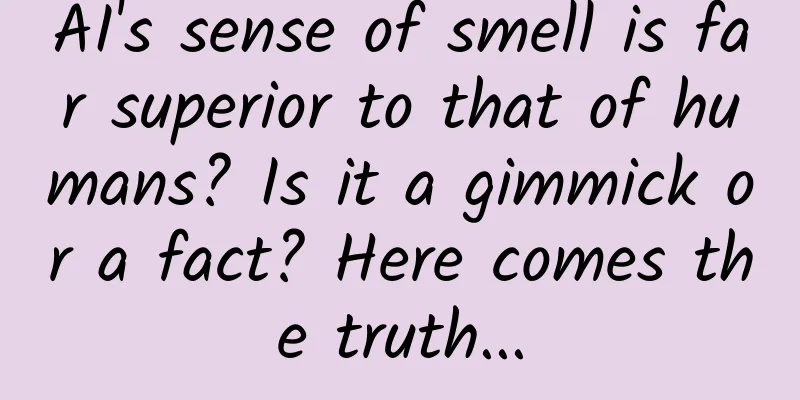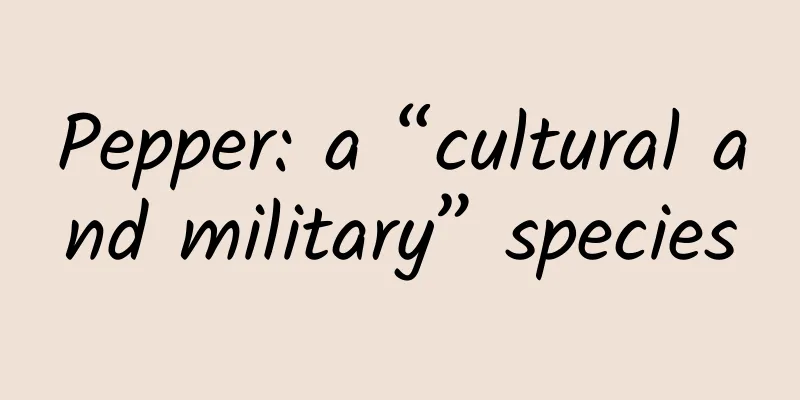AI's sense of smell is far superior to that of humans? Is it a gimmick or a fact? Here comes the truth...

|
gossip The sense of smell is one of the earliest senses formed by the human body. It is a very complex sensory response. The nose is like a highly sensitive detector. Through millions of olfactory nerves, we can perceive and distinguish various odor molecules with different structural characteristics so that we can make quick judgments in complex environments. With the continuous development of science and technology, artificial intelligence (AI) olfactory recognition technology that imitates human olfactory perception has developed rapidly. This technology combines advanced algorithms of machine learning and artificial intelligence, and can identify various substances by detecting and analyzing odor molecules. The application areas of AI olfactory technology range from environmental monitoring to medical diagnosis, from food safety to criminal investigation, and its potential is unlimited. Copyrighted stock images, no reproduction is authorized When AI has surpassed human capabilities in many sophisticated fields, there are also rumors that AI's sense of smell has far surpassed that of the human nose. So, who is better at smell perception? Before we reveal the answer to this question, let’s first understand the principles of how humans and AI perceive smells. analyze How does the human brain perceive smells? The process by which the brain perceives smell is like an encounter. First, odor molecules sneak into the nasal cavity. At the top of the nasal cavity is a special area called the olfactory epithelium . There are a large number of olfactory receptor cells here that can specifically recognize odor molecules. These odor molecules travel around in the nasal cavity, looking for their partners, which are our olfactory receptors . Humans have about 400 functional olfactory receptors. Once these receptors come into contact with odor molecules, they immediately cause electrical signal changes, performing an "electrical dance" to transmit signals to the brain. This signal travels directly through the olfactory nerve to a specific area of the brain called the olfactory bulb . Red is the olfactory bulb Image source: Reference [1] In the olfactory bulb, these signals are further processed and analyzed. The information is then sent to brain regions associated with memory and emotion, such as the hippocampus and amygdala. Finally, the brain converts these signals into odor sensations that we can recognize and understand, allowing us to perceive the smell's taste, texture, and other characteristics. Ultimately, the processing of olfactory nerve signals forms semantic representations that describe various smells, such as coffee, rose, durian, etc. This process is so magical and exquisite that it makes our lives full of the color and fun of taste. How does AI “smell”? We now have a general understanding of the principles and processes of how the human brain perceives odors, so how does AI smell various odors? AI "smells" odors like a "guessing game" based on molecular structure. Odors come from molecules with specific structures. These molecules are like "messengers" that carry odor signals. Therefore, to predict the odor of a substance, the key is to identify the composition and structure of the molecules. In this process, AI relies on a large and carefully organized database. This database can be regarded as an advanced "smell-molecule translation dictionary", which lists in detail the relationship between known molecular structures and their corresponding smells. The association between each molecule and smell is meticulously recorded and archived. A paper in the journal Nature Machine Intelligence reports a Neural algorithm used to simulate biological sense of smell Image source: Nature Machine Intelligence magazine When faced with the task of predicting the smell of a new molecule, AI will quickly search this professional "dictionary" to find known molecules with similar structures to the new molecule and infer possible odor properties from them. This process is not only fast, but also extremely accurate. In addition to basic structural matching, AI also takes into account other chemical properties, such as the electronegativity and stereo configuration of the molecule, to more comprehensively predict the odor characteristics of new molecules. The overall process is like an AI gathering and analyzing various clues to infer the smell that a new molecule might produce. In August 2023, a graph neural network (GNN) model for AI odor analysis was published in Science magazine. The process of AI identifying smells Image source: Reference [4] After the molecular structure is input into the model, GNN will optimize the weights of different chemical structures in a specific odor, and finally judge the odor of the molecule through the prediction layer and output the corresponding odor descriptor. The researchers conducted odor tests on the GNN model and the human group. The results showed that the AI outperformed the human experts in 53% of chemical molecules and 55% of odor description accuracy. Humans vs. AI: Who is the smell expert? We can imagine a team of professionals who are “smell experts”. Unlike AI, which relies on large amounts of data and algorithms, these experts rely primarily on their sense of smell and years of accumulated experience to parse and describe smells. They are able to identify the subtle differences in a variety of complex smells and describe them in precise language. For example, they can clearly distinguish between different types of smells such as floral, fruity, grassy, leathery, etc. and give them in-depth explanations. In addition, these odor experts can also analyze and interpret odors based on their sources and environmental factors. For example, they can distinguish odors produced during cooking, plant odors, and unique odors of animals, and systematically analyze the causes and effects of these odors based on their characteristics and changes. Unlike the predictions of data-driven AI, the descriptions and judgments of these smell experts can be subject to subjective factors. Their conclusions may vary from person to person and may even be affected by a variety of factors, so in some cases, their description of the smell may differ from the AI's judgment. Of course, this is just an imagination, and it does not mean that real smell experts are not professional. At the current stage, AI's sense of smell has not yet reached the level of crushing humans, and humans have irreplaceable advantages in the subjective experience and understanding of smell perception. First of all, faced with a complex odor spectrum, AI needs to rely on massive amounts of data and advanced algorithms for learning and simulation in order to output more accurate judgments. However, the human olfactory system can show higher flexibility, which is difficult for current AI systems to achieve. Prediction results of different AI models Correlation with human group mean Image source: Reference [4] Human sense of smell is also affected by many other factors, such as emotions, health status, life experience, etc. These factors may affect our perception and judgment of smell. These variables add a layer of complexity to human smell that AI lacks, making it difficult to fully understand and simulate the human olfactory system. in conclusion Although AI has shown impressive potential in olfactory technology and has made significant progress in some areas, it has not yet surpassed humans in all aspects. Each has different advantages and limitations. As technology continues to advance, we have reason to expect AI to achieve more breakthroughs in olfaction. However, this field still faces many challenges, such as accurate identification, stability and repeatability of odor molecules, which require further research and improvement. In addition, public acceptance and trust in this emerging technology are also key factors in promoting its successful application. In summary, AI olfactory technology has broad development prospects and unlimited possibilities, but its specific development trajectory and results still need time and practice to verify. We look forward to researchers and engineers solving these challenges and bringing more convenience and safety to society. References: [1]Edmund Chong, Monica Moroni, Christopher Wilson, et al. Manipulating synthetic optogenetic odors reveals the coding logic of olfactory perception Science 2020, 368, 6497. [2]Lulu Guo, Jie Cheng, Shuo Lian, et al. Structural basis of amine odorant perception by a mammal olfactory receptor. Nature 2023, 618, 193. [3]Jia Duan, Peiyu Xu, Xiaodong Luan, et al. Hormone- and antibody-mediated activation of the thyrotropin receptor. Nature 2022, 609, 854. [4]Brian K. Lee, Emily J. Mayhew, Benjamin Sanchez-Lengeling, et al. A principal odor map unifies diverse tasks inolfactory perception. Science 2023, 381, 999. Produced by Science Popularization China Author: Denovo team Producer丨China Science Expo The cover image and images within this article are from the copyright gallery. Reprinting and quoting them may lead to copyright disputes. |
<<: Young seals put eels in their nostrils, just to keep up with the trend? | Nature Trumpet
>>: Eating 2 handfuls of “young” soybeans every day has 6 great benefits for your body!
Recommend
This food has 7 or 8 times more calcium than milk! Unfortunately, many people don’t eat it right.
Expert of this article: Zhang Zhaomin, Master of ...
I spent 600 yuan in the morning and didn’t get any conversations, but my creative idea had a high click-through rate. How can I solve this problem?
Recently, I have received many messages from frie...
AI decides your university? Calculate your 7 personal qualities in minutes
Currently, many universities adhere to the concep...
What is this saltwater fish that has a strange appearance, a difficult name to write, and is difficult to tell male from female?
The brindle fish, commonly known as "butterf...
Analyze how to place information flow ads in the automotive industry from 3 perspectives
"Golden September and Silver October" i...
Practice: How to use data mining to convince your client?
This article is written at a milestone moment. On...
BYD Han EV's first winter test in northern China: Although the range has decreased, the cost per kilometer is still less than 0.1 yuan
With brands such as BYD, Xpeng, and NIO making gr...
Read "Young Marshal, Your Wife Ran Away Again" for free, and read "Young Marshal Gu Qingzhou" for free without pop-ups!
"Young Marshal, Your Wife Ran Away Again&quo...
16 industries, 29 cases, just read this article for information flow advertising!
The final effect of an advertisement is often det...
How to effectively collect user feedback in mobile apps
This article analyzes various mainstream feedback...
Live streaming + private domain traffic, an efficient marketing method in 2020!
Since 2020, two concepts have been very popular a...
New media operation and promotion planning and writing skills!
How to write a promotion plan for new media opera...
How to do offline pre-installation promotion of "Deepin" APP and what to pay attention to!
The operations uncle said: This article shares wi...
You know that “Guilin’s landscapes are the best in the world”, but have you ever thought that Guilin is everywhere in Guangxi!
The richness of Guangxi More than you think You m...
Charm Academy "Top Wealth Thinking"
Charm Academy "Top Wealth Thinking" Res...









